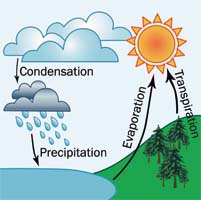
Ever gazed up into the sky and wondered, what’s in a cloud? Simply put, clouds are giant puffy masses that hang out in our atmosphere made up of tiny air droplets and ice. These droplets are super light, which allows them to float and drift effortlessly across the sky.

Clouds come in all shapes, sizes, and colors, forming all sorts of patterns. Have you ever watched the clouds long enough to see them morph into your favorite animal? Clouds are constantly moving across the sky and often catch the eye of a daydreaming onlooker. Watch them long enough and a whole story will play out before your eyes!

Here at CIMI, some of our favorite clouds to watch are the ones that set right above the ocean as the sun is rising in the morning. The colors turn all types of red, purple, orange, and yellow…it’s truly magnificent!

How are clouds formed?
To understand how clouds are formed, first we must understand the water cycle! Ever heard of it? This never-ending movement of water through the atmosphere is happening all the time through evaporation, condensation, and precipitation. This cycle starts when warm water vapor near the ground starts to rise and eventually cools. This cool air forms humidity, or clouds, and under certain conditions, rain or even snow will fall back down to earth. The process of air cooling below its saturation point forms the clouds you see every day.

Do we have names for the different cloud shapes?
Indeed, we do! Clouds are named and classified by their location in the atmosphere. We can thank a man named Luke Howard who created most of these names in 1803, and are still used all over the world when people talk about clouds. When we classify clouds, we use a system created by the World Meteorological Organization that divides them into 10 main groups. We divide them further into three categories: High clouds, Medium clouds, and Low clouds. Lots of fancy Latin names exist within those three categories, try your hand at pronouncing some of those names on the chart below!
![]()
See if you can name the different clouds found in the photos above! Or next time you find yourself cloud-gazing, try to put a cloudy name to the giant puffs that you see above you!



